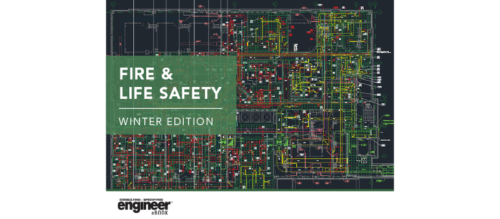Developing an NFPA 92 design analysis
By creating an NFPA 92 design analysis for smoke control systems, fire protection engineers can provide design fire scenarios and a detailed design report.
Learning objectives
- Identify at least two changes in the 2018 edition of NFPA 92: Standard for Smoke Control Systems.
- Understand critical aspects in the design report for a smoke control system, including the design fire scenario.
Smoke control systems typically are designed to meet the requirements of a prescriptive building or fire code or as part of a performance-based design or compliance alternative. The standard that is typically used for the design of such systems is NFPA 92: Standard for Smoke Control Systems.
The 2012 edition of NFPA 92 combined what had been previously published as NFPA 92A and NFPA 92B. There also are smoke control system design requirements found in the International Building Code, which may differ from the NFPA 92 requirements.
For example, the IBC provides pressure differences to be achieved for a smoke containment system designed for stair pressurization that are different from those in NFPA 92. However, this is based on the NFPA 92 pressure differences are to be achieved when the number of stair doors assumed to be open are open. The IBC indicates that the pressure differences are to be achieved with all interior stair doors closed. The design professional needs to be aware of the design criteria of the applicable codes and standards.
Like many NFPA codes and standards, NFPA 92 is typically revised on a three-year revision cycle. The technical committee currently is working on developing the 2021 edition and the work of the committee can be followed using www.nfpa.org/92. The current edition is the 2018 edition and will be referenced in this article.
What is new in the 2018 edition?
The 2018 edition of NFPA 92 is essentially the same as the 2015 edition. Other than updating reference standards and publications, there were only two significant technical changes.
The first and most significant change was to add an annex containing information on tenability (Annex M) to the document. The standard defines tenable environment as one in which smoke or heat are limited or otherwise restricted to maintain the impact on occupants to a level that is not life threatening. Tenability has been previously included in the standard as one of the objectives for smoke control systems and the committee thought the document should contain some guidance on determining tenability criteria.
In addition to tenability, there may be other design goals related to the design of a smoke control system and these are discussed in Paragraph 4.1.2 and the associated Annex note. These may include, but are not limited to:
- Containing smoke to the zone of origin.
- Providing safe egress time for the building occupants.
- Maintaining the smoke layer interface level to a predetermined height in large–volume spaces.
- Improving visibility for fire department response personnel.
- Limiting the spread of toxic gases.
- Protecting building contents by limiting the spread of the products of combustion.
The material contained in the new Annex is essentially the same as a similar Annex in NFPA 130: Standard For Fixed Guideway Transit and Passenger Rail Systems.
The other technical change is related to system verification features. The 2012 edition of NFPA 92 required verification of dedicated smoke control equipment through the use of the weekly self-test function required for a UUKL-listed smoke control panel. During the development of the 2015 edition of NFPA 92, the committee acknowledged that there may be situations where strict compliance with the UUKL weekly self-test would not be practical and other means of verification may be necessary.
The responsibility the frequency and capabilities to be tested was assigned to the design engineer and the authority having jurisdiction. However, this could result in widely disparate verification methods. The 2015 editions of the International Fire Code and International Building Code included additional verification methods as an alternate to the weekly self–test requirement. The new language reverts back to the listing requirement and adds a description of acceptable alternatives to the weekly self-test that are consistent with the requirements of the 2015 IFC and IBC.
Detailed design report
Although the requirements have not changed in the 2018 edition, the design engineer needs to properly document the rational and basis for the design of a smoke control system. During a recent discussion with a fire official, it was noted that they typically are not provided with such documentation. NFPA 92 provides a detailed description of what is to be included in the detailed design report (Paragraph 7.2).
While most smoke control systems are designed and installed to meet a specific code requirement, there are many that are provided for other reasons. The design report needs to identify the purpose and design objectives associated with the smoke control system. This is especially true when the system is part of a performance-based design or a compliance alternative (equivalency) because the design objectives may not be directly related a prescriptive code requirement. The new Annex regarding tenability provides some useful information for those systems in which tenability is one of the design objectives.
The assumptions made by the design team and the building use limitations need to be clearly stated and in terms that can be understood by all stakeholders. For example, several years ago I reviewed a report produced by one of our engineers in which the engineer clearly stated that one of the assumptions was that the fire growth rate would be similar to a medium–growth, t-squared fire. While the engineering team and code officials may understand that concept, it provided no guidance to the building owner as to what the limitations may be on the contents that could be used in the space. When I challenged the engineer to expand the report to provide guidance to the building owner, the engineer was not sure how to explain the use limitations in a manner that could be understood by the owner. The report was improved by describing common characteristics of contents that are likely to result in a medium–growth, t-squared fire — along with photographs.
Other building use limitations could include assumptions related to the occupants such as mobility, density and awareness. Clearly changing an office area to an assembly space is likely to result in an increase in density of the occupants, which may increase the time to evacuate an area. Changing a patient sleeping area in a hospital to a wing that provides sleeping accommodations for staff or patient family members results in a change in awareness by the occupants. While both involve sleeping accommodations, in a patient sleeping area of a hospital the area is supervised by staff while no one is likely to supervise or check-in on conditions inside a staff or family sleeping room.
Design fire scenario
A critical aspect in the design of a smoke control system is determining the design fire scenario or scenarios to be used. The scenario should adequately describe the fire or fires that have been used to determine the performance requirements of the smoke control system. While design fire scenarios need to be project specific, NFPA 92 contains some annex material that can assist the engineer in determining the specific fire scenario (see Annex B).
Other sources of information could be the design fire scenarios contained in NFPA 101 (Chapter 5) and the Society of Fire Protection Engineers Handbook of Fire Protection Engineering. See the sidebar “Sample design fire scenario.” Note that the scenario includes relevant assumptions regarding the potential fire scenario and describes the meaning of the fire in terms that can be understood by the building owner. The scenario is then likely to be analyzed using computational fire dynamics.
An aspect not always included in the design details is the interaction with other smoke control systems and with building heating, ventilation and air conditioning systems. NFPA 92 requires that when multiple smoke control systems are used, the individual systems must meet their respective design objectives (Paragraph 4.2). The IBC requires that the interaction of smoke control systems shall be included in the design analysis, along with the interaction with the building HVAC systems (Section 909.4). When this interaction is not properly addressed by the design calculations, the system(s) may not perform as intended during commissioning or during a fire event.
Finally, the detailed design report needs to identify the procedures to be used for commissioning the system. The design report will be used to set the acceptance criteria for the commissioning. An example is the provision in the code that requires the fire analysis to consider the time it takes to start up the smoke control systems (fans, dampers, etc.). This is a critical piece of information that should be specifically included in the design report.
NFPA 92 addresses the requirements associated with the acceptance test for the smoke control system. In addition, NFPA 3: Standard for Commissioning of Fire Protection and Life Safety Systems provides the criteria for commissioning fire protection systems and NFPA 4: Standard for Integrated Fire Protection and Life Safety System Testing provides the requirements for testing integrated fire protection systems. The 2018 edition of NFPA 101: Life Safety Code requires that smoke control systems be tested in accordance with NFPA 4 for new high-rise buildings and in most occupancies.
Smoke control systems are different from many of the building systems designed by professional engineers in that the designs are more commonly performance based. The design criteria typically are determined based upon the established design objectives. The design engineer needs to identify the design fire scenarios to be used to evaluate if the system design will achieve the established objectives. A detailed design report must be prepared so that all stakeholders have a complete understanding the design and the assumptions related to the design.
Do you have experience and expertise with the topics mentioned in this content? You should consider contributing to our CFE Media editorial team and getting the recognition you and your company deserve. Click here to start this process.






